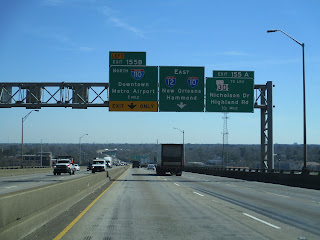Standing tall across from downtown Baton Rouge, the Horace
Wilkinson Bridge carries Interstate 10 across the lower Mississippi River
between West Baton Rouge and East Baton Rouge Parishes. Unusually, the bridge is
actually named for three separate people; three generations of Horace
Wilkinsons who served in the Louisiana State Legislature over a combined period
of 54 years.
Constructed in the 1960s and opened to traffic in 1968, this is one of the largest steel bridges on the lower Mississippi. It’s also the tallest bridge across the Mississippi, with its roadway reaching 175 ft at the center span. Baton Rouge is the northernmost city on the river where deep-water, ocean-going vessels can operate. As a result, this bridge is the northernmost bridge on the river of truly gigantic proportions. Altogether, the bridge is nearly 2 ½ miles long and its massive truss superstructure is 4,550 ft long with a center main truss span of 1,235 ft.
As part of the busy I-10 corridor across southern
Louisiana, this bridge sees some of the heaviest traffic of any bridge on the
lower Mississippi. This problem is compounded by the fact that for a
metropolitan area the size of Baton Rouge (the state’s capital and 2nd
largest metro area), cross-river traffic is handled by only two bridges, the
other being the much older Huey P. Long Bridge a short distance to the north.
The high amount of local traffic mixing with the already significant
long-distance traffic on the interstate makes for a bridge that is always prone
to congestion at all hours of the day. In addition, the bridge’s roadway lacks
full shoulders, a common safety feature on most interstate highway bridges. The
roadway does carry six lanes for traffic, yet two of these lanes (one per
direction) are reserved for local entering/exiting traffic at the interchanges
on each bridge approach.
Altogether, this is a bridge that has needed supplementation for many years and the state of Louisiana is not in a position at this time to offer any significant solutions to the traffic bottleneck that the bridge and its approaches represent. The state has instead chosen to pursue bridge projects in other areas of the lower Mississippi basin that have had negligible impacts on traffic congestion, whether in the Baton Rouge area or elsewhere, and the state has generally neglected the needs of its capital region by overlooking the traffic demands generated in this particular stretch of the river. In this author’s opinion, southern Louisiana would be well-served to consider the construction of a third bridge in Baton Rouge, whether as a parallel span for the existing Wilkinson Bridge, or on an alignment nearby that would enable much of the long distance traffic on the interstate to bypass Baton Rouge. The two bridges that serve this area are not getting any younger and it may be time to take their age and lessening effectiveness seriously so that a real effort may emerge to modernize the region’s transportation infrastructure with the goal that it will be compatible with the demands of the 21st Century.
Further Reading:
Horace Wilkinson Bridge by John Weeks
Horace Wilkinson Bridge at historicbridges.org
Bridges, Crossings, and Structures of the Lower Mississippi River
Next Crossing upriver: Huey P. Long Bridge (Baton Rouge, LA)
Next Crossing downriver: Plaquemine Ferry (Plaquemine, LA)
Next Bridge downriver: Sunshine Bridge (Donaldsonville, LA)
Return to the Bridges of the Lower Mississippi River Home Page
__________________________________________________





































































Comments